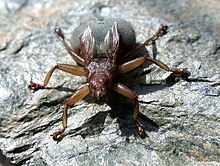Common swift fly
| Common swift fly | ||||||||||||
|---|---|---|---|---|---|---|---|---|---|---|---|---|

Common Swift Louse Fly ( Crataerina pallida ) |
||||||||||||
| Systematics | ||||||||||||
|
||||||||||||
| Scientific name | ||||||||||||
| Crataerina pallida | ||||||||||||
| ( Latreille , 1811) |
The common swift louse fly ( Crataerina pallida ) is a two-winged fly from the family of louse flies (Hippoboscidae).
features
Starving swift flies are 6.3 to 8.1 millimeters long, of which about three millimeters are on the head and thorax . Soaked with blood, they reach lengths of 7.4 to 9.9 millimeters, with the males being slightly smaller than the females. Its body is flattened and a dirty gray-brown color, while the head and thorax are darker in color than the legs . The abdomen is translucent, so the translucent hemolymph turns it green. The wings are triangular, three times as long as they are wide and pointed at the end. They are 4 to 4.5 millimeters long. This is a little more than the length of the abdomen before a blood meal. With its shortened wings, this louse fly can sail in a controlled manner, but not actively fly.
Occurrence and way of life
The common swift louse fly is a parasite whose host animals are mainly common swifts , but also swallows . They cling to the birds' bodies and suck blood - in extreme cases they can go hungry for up to 20 days in cool temperatures. The life cycles of the fly and the host animals are strongly synchronized. The larvae develop exclusively in the uterus of the female, which is called viviparia , and feed on secretions produced there (adenotropic). The larvae are deposited below or some distance from the sailor's nest when they have reached the third instar. They pupate almost immediately.
When the birds have completed their breeding business and no longer visit the nests at the top of the house walls, under the eaves, the flies can actively penetrate human living spaces. The bites are very painful and the itchy wheals last for about a week. The common swift fly probably shares its range with its host animals.
literature
- Joachim and Hiroko Haupt: Flies and mosquitoes: observation, way of life . Naturbuch-Verlag, Augsburg 1998, ISBN 3-89440-278-4 .
- Udo Sellenschlo: The swift louse fly and related species . In: The practical pest controller 1/2007, ISSN 0032-6801 .
Individual evidence
- ↑ Mark D. Walker, Ian D. Rotherham: The Common Swift Louse Fly, Crataerina pallida: An Ideal Species for Studying Host-Parasite Interactions. In: Journal of Insect Science. 10: 1-15, 2010
